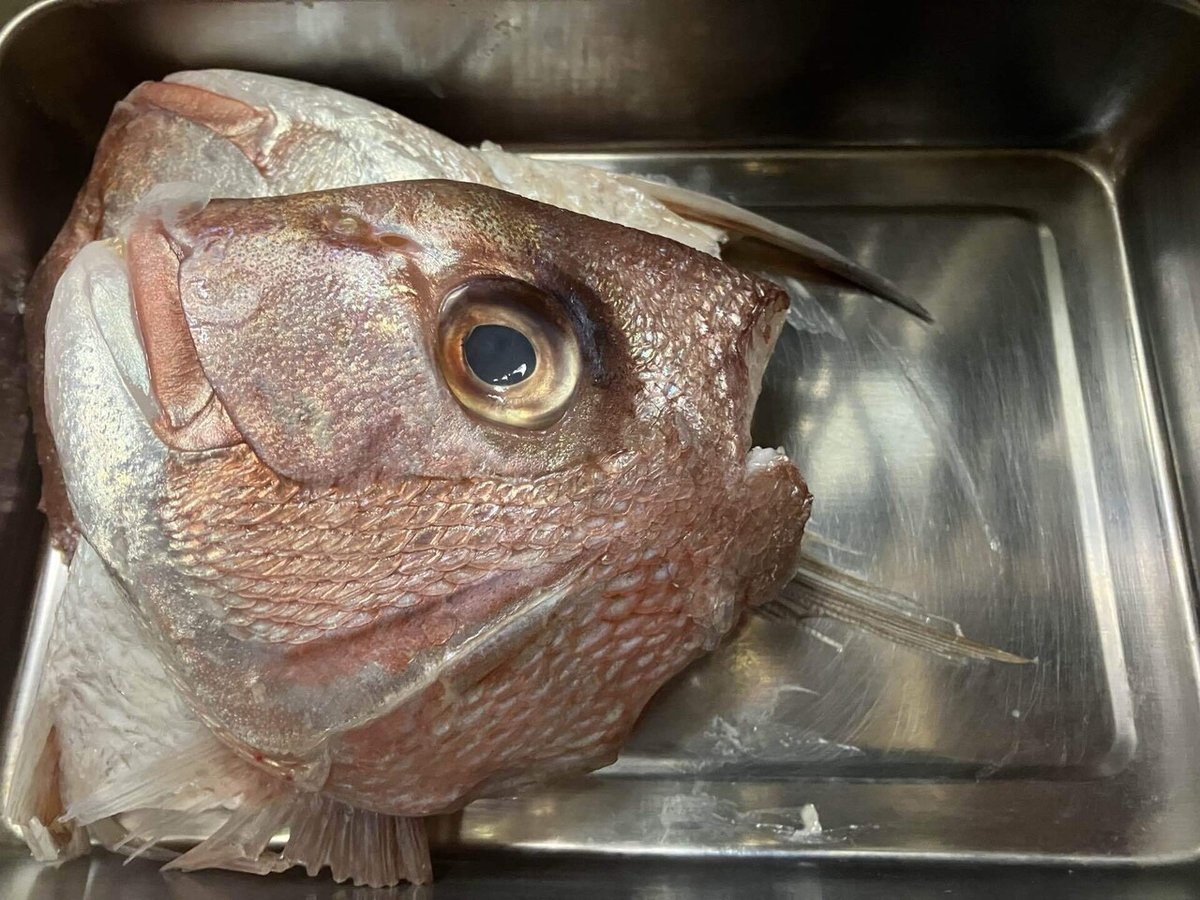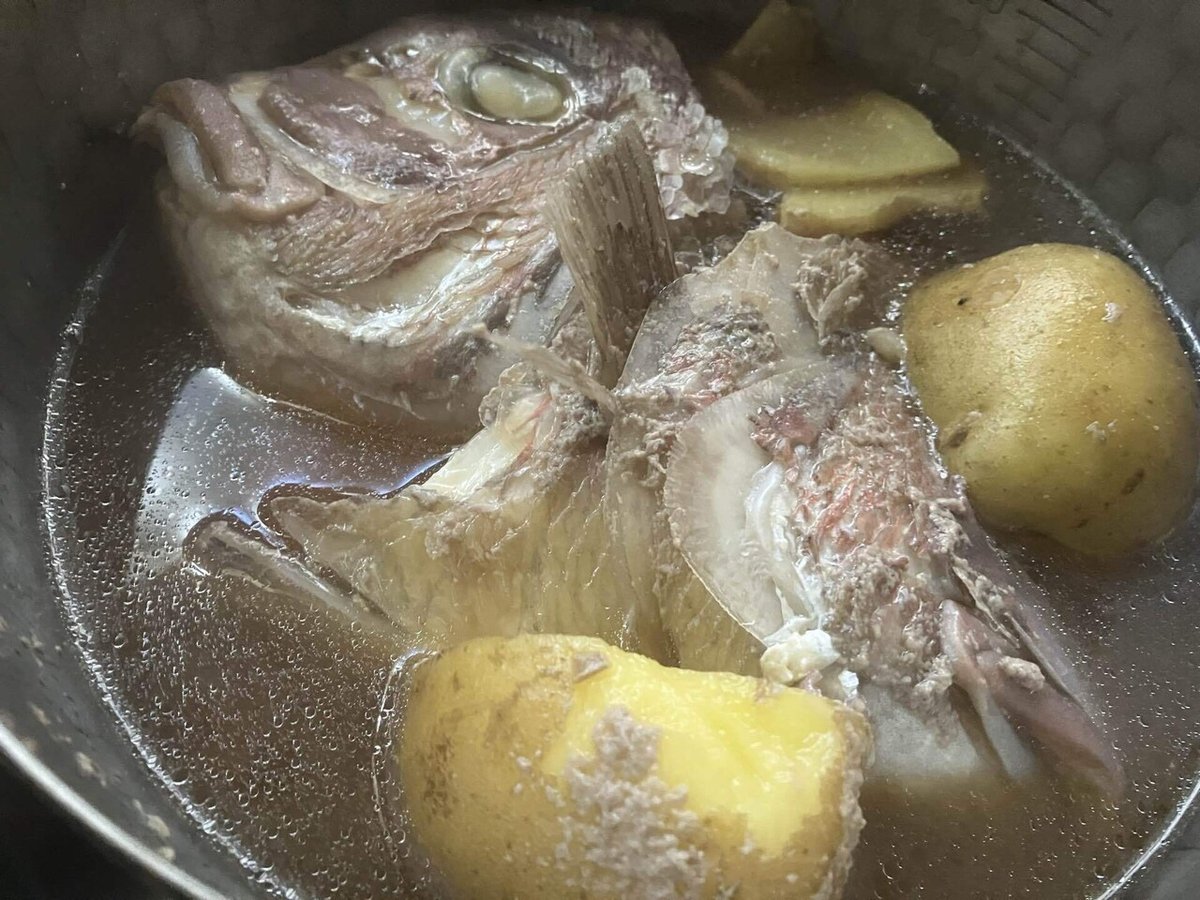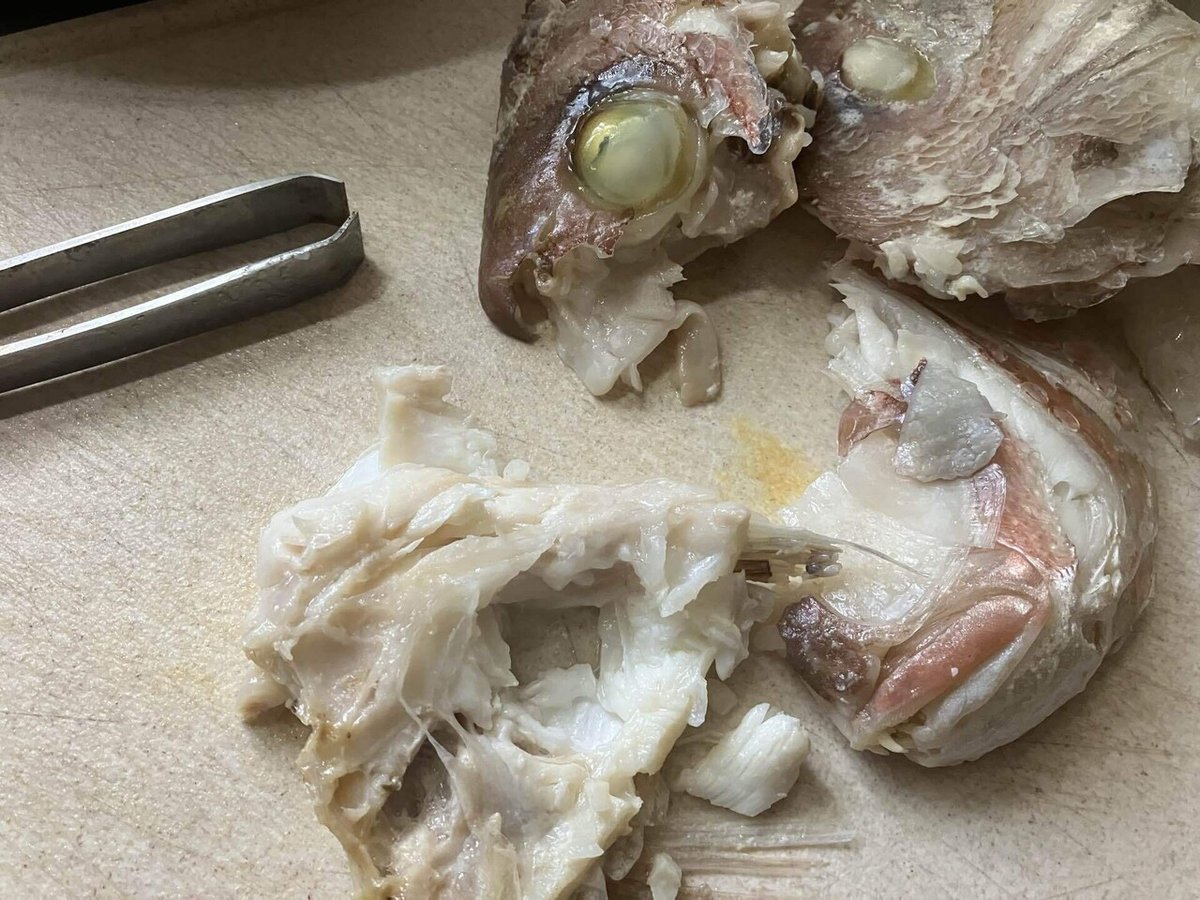
たまには貧乏人もお頭付き大ご馳走で一献 Sometimes, even the poor man can enjoy a meal of a whole sea bream, which brings good luck.
貧乏人の歳時記 A minimalist's seasonal calendar
ストーリー
Recipe trivia
ごめんなさい。写真は羊頭狗肉です。見栄を張りました。「お頭付き」ではなく「お頭だけ」です。
Sorry. The photo is of wolf meat in sheep's clothing. I was showing off. It's not "fish with head" but "only fish head".

酔いどれんぬさんごめんなさい。タイトル真似しました。いつもあまりに美味しそうな酒宴なので、羨ましくなりました。
Sorry, "Mz. Yoidorennu" I imitate the title. The drinking parties always look so delicious, so I'm envious as I read them.
日本ではおめでたい行事には、鯛丸ごと一匹を姿のまま(お頭付き)料理する習慣がある。通常、魚から刺身などの切り身(フィレ)を取ると、頭が残る。丸ごと一匹ならおめでたい席に使うけど、切り離された魚の頭だけだと、単なるアラでしかない。だから投げ売りされる。この鯛の頭は近くのスーパーで百円台、半分に割ってあるから一切れは百円しない。一匹丸ごとだと小ぶりでも千五百円以上になるので、ただでも良いけど一応商売だから値付けしました、という体の値段だ。スーパーでは鯛の刺身を売っている。お正月の準備の時期でもなければ、丸ごと一匹隊売ることは稀なので、刺身を取ると頭が余る。だから、必ず魚売り場の角の方の特売コーナーでお頭だけを売っている(尻尾は付いていないので、「尾頭」ではなく「お頭」だけど)。誰も見向きもしないのか、大抵は売れ残り、夕方にはさらに半額になっている。夕方売れ残っているのを、半額で喜んで買う客の顔ぶれは大体同じで、僕もその一人。全然自慢できる話ではないが、立派な貧乏人だ。
もちろん、ちゃんとした料理人はアラを捨てたりしない。丸ごと一匹仕入れて、頭は出汁を取ったり、気の利いた潮汁にしてサービスしてくれる。鯛飯も頭と一緒に炊かなければ美味しくない。アラは、適切に処理をしさえすれば、味の塊でご馳走だからだ。残念ながら鯛の刺身は無いけれど、頭だけ職人仕事をして、ご馳走と思うことにしている。
このスーパーは元々魚屋だったので、鯛以外にも、「あやかり鯛(鯛に似た風貌の魚に、〇〇鯛と名付けるとよく売れるので、日本には鯛という漢字の付いた魚が多い)」のお頭も破格の値付けで売ってくれる。ありがたいことだ。
In Japan, there is a custom of cooking a whole sea bream (o-kashira-tsuki / with head and tail) for auspicious occasions. Usually, when you take fillets for sashimi, the head is left behind. If you take a whole fish, it is used for auspicious occasions, but if you only take the head, it is just a fish waste. That is why it is sold at a bargain price. This sea bream head is in the 100 yen range at a nearby supermarket, and since it is cut in half, each piece is less than 100 yen. If it is a whole fish, even a small one would cost more than 1,500 yen. Sea bream sashimi is sold at supermarkets. It is rare to sell a whole fish unless it is New Year's preparation time, so if a cooking person take the sashimi, the head will be left over. That is why the head is always sold at the special sale corner in the corner of the fish section. No one seems to pay attention to it, so it usually remains unsold, and by the evening it is half price. The same customers would happily buy any unsold items at half price in the evening, and I’m one of them. It's not something to brag about, but I’m a proper poor person.
Of course, a good chef wouldn't throw away the bones. They buy the whole fish and use the head to make a stock or a nice soup, which they serve. Sea bream rice isn't tasty unless it's cooked with the head. If the head and.bones are properly prepared, they're a delicious treat with a lot of flavor. Unfortunately, they don't have sea bream sashimi, but If handled properly, fish heads are a treat.
This supermarket was originally a fish shop, so in addition to sea bream, they also sell the heads of "ayakari sea bream" (fish that look like sea bream and are named after something like 'tai' sell well, so there are many fish in Japan with the kanji character for '鯛 tai') at an exceptional price. What a blessing.
今回はお頭を使って作ったのは二品。
一品目は、普通に家庭料理の「鯛の煮付け(煮魚)」。身だけで作っても良いのだけど、頭の骨やゼラチン質が加わると格段に美味くなる。負け惜しみだが、お頭だけでも十分楽しめる料理だ。「煮魚」は世界中に類型の料理が存在する。焼魚と並んで魚料理の基本だ。塩だけの味付けのものから、地域の調味料を使った個性豊かなさまざまな種類の煮魚が存在する。インド文化圏の海辺には香辛料で煮込んだ様々な魚のカレーがあるし、東南アジアでは、魚醤や爽やかなハーブで味付けした煮魚がある。西洋料理のブイヤベースやアクアパッツァもこの仲間だ。
今では、日本で煮魚といえば甘辛に煮付けるのが主流だけど、これは戦後の流行。それ以前は、甘味は入れず、味噌やたまり醤油で煮たり、塩煮にする方が普通だった。沖縄に行くと、その原型に近い煮魚がある。「マース(塩)煮」だ。魚の旨みを純粋に味わえる秀逸な料理だ。時にはイーチョーバー(茴香/フェンネル)を入れることもある。これなどは、まさに東洋版ブイヤベースといった味わいになる。ここでは、甘みをあえて入れずに醤油だけで煮たレシピにしてある。世界中の煮魚を食べてみて、煮魚の甘みは蛇足と感じる様になってきて、僕はもっぱらマース煮とこの煮方を常とするようになった。
This time, I made two dishes using the fish head.
The first dish is a typical home-cooked dish called "simmered sea bream (nizakana)." It's fine to make it with just the meat, but adding the bones and gelatin of the head makes it so much tastier. It may be a bit of a sore loser, but this dish is enjoyable enough with just the head. "simmered fish" dishes exist all over the world. Along with grilled fish, it is a basic fish dish. There are many different types of simmered fish, from those seasoned only with salt to those that use local seasonings and have a unique character. In the Indian cultural sphere, there are various fish curries stewed with spices on the coasts, and in Southeast Asia, there is simmered fish seasoned with fish sauce and refreshing herbs. Western dishes such as bouillabaisse and aqua pazza also belong to this category.
Nowadays, in Japan, simmered fish is usually cooked in a sweet and spicy sauce, but this was a postwar trend. Before that, it was common to boil fish in miso or tamari soy sauce, or in salt, without adding any sweetness. If you go to Okinawa, you will find a simmered fish dish that is close to the original. It is called "Maas (salt) simmered". It is an excellent dish that allows you to taste the pure umami of the fish. Sometimes fennel is also added. This tastes just like an oriental version of bouillabaisse. Here, the recipe is simmered in soy sauce only, without adding any sweetness. Having eaten simmered fish from all over the world, I have come to feel that sweetness in simmered fish is unnecessary, so I have started to use Maas(salt) simmered fish and this method of cooking exclusively.
二品目は「鯛飯」。鯛飯は、鯛の養殖が盛んでその出荷量が日本一の愛媛の郷土料理だ。実は愛媛には二種類の鯛飯がある。「宇和島鯛飯」と「松山鯛飯」だ。宇和島鯛飯は、炊きたてのご飯の上に鯛の刺身の漬けを乗せた料理だ。「日向飯」とも呼ばれる。現代的には卵と一緒に混ぜて、卵かけご飯の要素を加えたレシピに進化している。元々は、瀬戸内の村上水軍が好んだ「漁師飯」だった。この手の漁師飯については、直前の記事で詳しく紹介しているので、興味のある方はご参照ください。松山鯛飯の方は、いわゆる炊き込みご飯。お頭付きで鯛を丸ごと一匹炊き込むお祝い事の席に相応しい豪華な料理だ。土鍋で副材料を一切入れず、昆布だけで炊き込むのが松山流だ。お客さんに、土鍋の蓋を開けて炊き上がりの姿を見てもらってから、一旦鍋を下げ、職人が骨を取り除いて身だけをほぐして、改めてお客に個別に配膳するパフォーマンスを伴う。目でも楽しめる料理だ。
この類型の料理も世界中に存在する。インドの炊き込みご飯である「ビリヤニ」や「プラオ」でも、丸ごと魚を炊き込んだりする。中国や中東でも似た料理を食べたことがある。中国では使い込んだ土鍋で炊いた魚ご飯をいただいた。
The second dish is "Tai-meshi" (rice with freshly caught sea bream). Tai-meshi is a local dish of Ehime, which is the number one producer of sea bream in Japan. In fact, there are two kinds of tai-meshi in Ehime: "Uwajima tai-meshi" and "Matsuyama tai-meshi". Uwajima tai-meshi is a dish of pickled sea bream sashimi served on top of freshly cooked rice. It is also called "Hyuga-meshi". In modern times, it has evolved into a recipe that mixes it with eggs and adds the element of raw egg on rice. Originally, it was a "fisherman's meal" favored by the Murakami Navy(Japanese pirate) of the Seto Inland Sea. This type of fisherman's meal is introduced in detail in the previous article, so please refer to it if you are interested. Matsuyama tai-meshi is a so-called "cooked rice". It is a luxurious dish suitable for celebratory occasions, where a whole sea bream with its head is cooked. The Matsuyama style is to cook it in a clay pot with no side ingredients and only with kelp. The waiter opens the lid of the clay pot to let the customers see the rice and fish being cooked, then the pot is taken back to the kitchen where the chef removes the bones and separates the fish meat, then serves it individually in each customer's bowl - a visual treat as well.
This type of cuisine also exists all over the world. Indian rice dishes such as "Biryani" and "Pulao" often contain whole fish. I have eaten similar dishes in China and the Middle East. In China, I had fish rice cooked in a well-used clay pot.
この日は、お頭だけを四切れ手に入れたので、二切れづつ使って、この二品を作った。ちなみに四切れ入りで二百円だった。
On this day, I got four pieces of the head, so I used two pieces each to make these two dishes. By the way, four pieces cost 200 yen.
Ingredients:
材料:
鯛の頭(もちろん身がついていれば豪華)
米
じゃがいも(付け合わせの適当な野菜。人参とか牛蒡とか、お好みで)
生姜
昆布
薄口醤油
濃口醤油
自然塩
Sea bream head (of course, if it has meat on it, it's gorgeous)
Rice
Potatoes (any vegetable you like as a side dish. carrots, burdock, or whatever you like)
Ginger
Konbu kelp
Light type soy sauce
Dark type soy sauce
Natural salt
procedure:
手順
鯛の頭についている血合をよく洗い流す。
Wash the blood off the head of the sea bream thoroughly.
(鯛の煮付け)
鍋に、鯛の頭、スライスした生姜、付け合わせのじゃがいもを入れ、水をひたひたに注いで、濃口醤油と薄口醤油を半量づつ入れる。煮詰まるので、味付けは極々薄くて良い。
落とし蓋をして、魚に火が入るまで強めの中火(煮汁が対流する程度)で煮る。
魚だけを取り出し、アルミ箔などを被せ、保温しておく。
落とし蓋無しで、煮汁を野菜に絡めながら、さらに煮詰める。
煮汁が丁度良い濃さに煮詰まったら、火を止め、野菜を魚に添えて、煮汁を回しかける。
(Simmered sea bream)
Put the sea bream head, sliced ginger, and accompanying potatoes in a pot, pour in water until it is completely covered, and add half each of the dark type and light type soy sauces. The seasoning can be very light, as the fish will reduce.
Cover with a drop lid and simmer over high medium heat (enough for the broth to circulate) until the fish is cooked through.
Remove the fish and cover with aluminum foil or something similar to keep warm.
Without the drop lid, continue to simmer the broth with the vegetables, mixing it in.
When the broth has reduced to the desired thickness, turn off the heat, add the vegetables to the fish, and pour the broth over it.






(鯛飯)
厚手の鍋に米を研いで、分量の水と昆布を入れ、吸水させておく。
米の味付けは、塩でほとんど決め、少量の薄口醤油で味を整える。鯛と昆布から十分な旨味と脂が出るので、薄味で良い。
鯛の頭を入れ、蓋をして強火で加熱する。
沸騰してきたら火を弱め、十五分前後炊いて、火を止め、十分蒸らす。
鯛の頭をそっと崩れないように取り出し、骨抜きなどを使って骨やうろこを除き、身とゼラチン質の部分だけ鍋に戻す。
米を潰さないよう、ざっくり混ぜて、茶碗に入れて供する。
(Sea bream rice)
Wash the rice in a thick-bottom pot, add the specified amount of water and kelp, and leave to absorb the water.
Season the rice mostly with salt, and add a small amount of light soy sauce to taste. The sea bream and kelp bring out plenty of flavor and fat, so a light seasoning is fine.
Add the sea bream head, cover, and cook over high heat.
When it starts to boil, reduce the heat and simmer for around 15 minutes, then turn off the heat and leave 10 minutes to steam thoroughly.
Gently remove the sea bream head so that it does not fall apart, and use a boner to remove the bones and scales, and return only the flesh and gelatinous parts to the pot.
Mix roughly, being careful not to crush the rice, and serve in rice bowls.






Tips and tricks:
コツと応用のヒント:
ここでは、鯛の鮮度が抜群だったので、そのまま血合をよく洗い流しただけで使っているが、鮮度落ちが気になる場合は、前もって熱湯を回しかけたり、軽くグリルしてから使うと良い。グリルすると香ばしさが出るので、それを狙うなら、鮮度が良くても、グリルすると良い。宇和島鯛飯のオリジナルは、グリルしてから炊き込んでいる。
煮物に加える野菜は、ここでは、たまたま余っていたじゃがいもを使っているが、この季節なら、牛蒡や人参、インゲン、薩摩芋、蓮根、菊芋、真菰竹、玉ねぎなどを添えても良い。蓮芋の茎や里芋の蔓を添えるのもありだ。冬なら、大根やキノコ類を使っても良い。根菜類など硬くて火の通りにくい素材と一緒に魚を煮ると、魚に火が通り過ぎてしまうので、魚を先に取り出している。その辺りは、添える野菜の火の通り具合で調節すると良い。また、単純にじゃがいもを火の通りやすいよう小さく切って、魚と同時に煮上げても良い。
ここでは僕の個人的好みから、あえて、白身魚の味を引き出すために、甘みは加えず、極々薄い醤油味で煮ている。濃口醤油は主張しすぎるので、薄口醤油をブレンドして使っている。白身の淡い味を楽しみながら塩味の調節ができるように、濃いめに煮詰めた煮汁を後で回しかけて仕上げてある。
赤身の脂の乗った魚なら甘みを補うのもありだ。もちろん個々人の好みの問題なので、普通に砂糖や味醂を入れても良いし、濃口醤油だけあるいは薄口醤油だけで煮ても良い。
ご飯を炊くのに、僕は炊飯器を持っていないので、五層構造のステンレス無水鍋を使っている。丈夫でもう40年近く経つが、ピカピカの現役だ。土鍋も良いが、より応用範囲の広いのがステンレスの無水鍋。アメリカの知り合いの主婦は「ママからのお下がりなのよ」と言って、ぼく以上長く使っている。一つ持っていると一生使える。もちろん、普通に炊飯器を使っても構わない。
鯛飯は、米の甘みと鯛のフレーバーを純粋に味わってもらうために、コンブと塩とほんのわずかの薄口醤油だけで最低限の味付けをしてある。味醂や濃口醤油を入れたい人もいると思うけど、そこはお好みで。
鯛飯で肝要なのは、徹底的に骨や鱗を除くこと。骨や鱗が舌にあたると、神経がそっちに行ってしまい、香りが鼻に抜ける楽しみと味わいが半減してしまうので、手早くても徹底した仕事をすること。新橋にあった宇和島料理の割烹「宇和島」の大将は、この仕事の時だけは必ず眼鏡をかけて集中力を注いだ仕事をしておられた。閉店してしまい、とても残念。
炊き込んだ昆布も旨みの塊なので、サービスする時に、そっと茶碗の底に敷いておこう。
最後にもう一度負け惜しみだけど、頭一匹分で二合のご飯に十分な鯛のフレーバーが行き渡る。余ったら、夜食のお握りにしておくとよい。
Here, the sea bream was extremely fresh, so I used it as is, just rinsing off the blood, but if you are concerned about it losing its freshness, you can pour boiling water over it beforehand or lightly grill it before using it. Grilling brings out a fragrant flavor, so if that's what you're aiming for, it's best to grill it even if it's fresh. The original Uwajima sea bream rice is grilled before cooking.
Here, I used potatoes that happened to be left over as vegetables to add to the stew, but at this time of year, you could also add burdock, carrots, green beans, sweet potatoes, lotus root, Jerusalem artichoke, enlarged stem of makomo(Zizania latifolia) and onions. You could also add sweet potato stems or taro vines. In winter, you could use radishes or mushrooms. If you simmer fish with root vegetables, which are hard and difficult to cook, the fish will overcook, so I remove the fish first. You can adjust the cooking time depending on how well the vegetables are cooked. You can also simply cut the potatoes into small pieces so that they cook quickly and cook them at the same time as the fish.
Here, based on my personal preference, I simmer the fish in a very light soy sauce flavor without adding any sweetness, in order to bring out the flavor of the white fish. Since dark type soy sauce has too strong flavor, I use a blend to it with light type soy sauce. I finish by pouring over the fish with a thick broth that has been reduced, so that you can adjust the saltiness while still enjoying the light flavor of the white fish.
If you use oily red meat fish, you may add sweetness to it. Of course, it's always a matter of personal preference, so you can add sugar and mirin, or you can cook it with only dark type soy sauce or only light type soy sauce.
If you use lean, oily fish, you can add sweetness to it. Of course, it's a matter of personal preference, so you can add sugar and mirin, or you can cook it with just dark or light soy sauce.
I don't have a rice cooker to cook rice, so I use a five-layer stainless steel waterless pot. It's sturdy and is almost 40 years old, but I'm still using it. Clay pots are good, but stainless steel waterless pots are more versatile. A housewife I know in the United States said, "It was a hand-me-down from my mother," and has been using it for longer than I have. Once you have one, you can use it for a lifetime. Of course, you can also use a regular rice cooker.
The Sea bream rice is minimally seasoned with kelp, salt, and a little light type soy sauce, so that you can enjoy the pure sweetness of the rice and the flavor of the sea bream. Some people may want to add mirin or dark type soy sauce, but that's up to your preference.
The most important thing about sea bream rice is to thoroughly remove the bones and scales. If the bones or scales touch your tongue, your nerves will be drawn to them, and the enjoyment of the aroma and flavor will be halved, so you need to work quickly and thoroughly. The owner of the Uwajima cuisine restaurant "Uwajima" in Shinbashi always wore glasses when doing this job, concentrating on his work. It's a shame that it closed.
The cooked kelp is also full of flavor, so when serving, gently place it in the bottom of the bowl.
Finally, I'm being a sore loser, but one head is enough to fill two cups of rice with sea bream flavor. If you have any left over, it's a good idea to make rice balls for a late-night snack.
Guide to where to get ingredients and equipment 材料と機材の入手先ガイド
※Amazonのアフェリエイトに参加しています。もしご購入の際はここからクリックしてご購入いただけると、コーヒー代の足しになるので、嬉しいです。ちなみに僕はコーヒー依存症です。
*I participate in Amazon affiliate programs. If you purchase this product by clicking here, it will help pay for my coffee, so I would be verhy happy. By the way, I am addicted to coffee.
